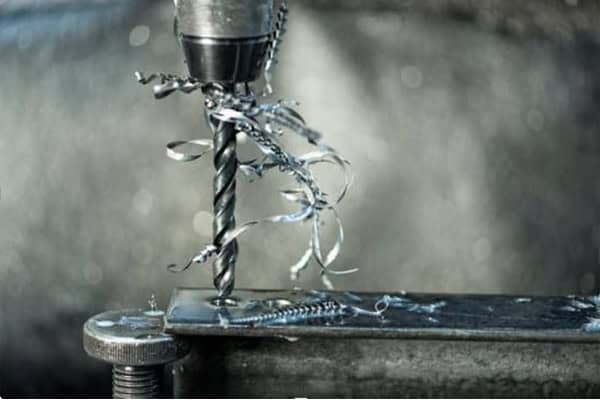
Drilling stainless steel might seem tricky, but with the right tools and techniques, it’s totally doable. Whether you’re a seasoned professional or a DIY enthusiast, mastering this skill can open up a world of possibilities for your projects.
To drill stainless steel effectively, use the right drill bit, such as an HSS6542 (M2) or cobalt bit. Lubrication with cutting fluid helps reduce heat and friction, ensuring precision. Maintain a steady speed and moderate pressure to avoid damaging the bit or material, ensuring clean, accurate holes.
Using the wrong tools can lead to dull bits, overheating, and poor-quality holes. Selecting high-quality bits designed specifically for stainless steel ensures precision and longevity, saving you time and frustration in the long run.
Let’s dive into the essentials of drilling stainless steel to make the process smoother and more efficient.
Which Drill Do You Use to Drill in Stainless Steel?
When it comes to drilling stainless steel, the drill bit you choose is a game-changer. The right drill bit not only makes the job easier but also ensures that the holes are clean and precise, reducing the risk of damaging your material.
For drilling stainless steel, an HSS6542 (M2) drill bit is highly recommended. This type of bit is specifically designed to handle the hardness and toughness of stainless steel. Additionally, cobalt drill bits1, which are a type of high-speed steel (HSS) drill, come in two variants: M35 (5% cobalt) and M42 (8% cobalt). While M42 bits are slightly better in terms of durability and heat resistance, M35 bits are usually the preferred choice because they offer great performance without the higher price tag. The amber color coating on cobalt bits helps in identifying them easily and provides an extra layer of protection against heat.
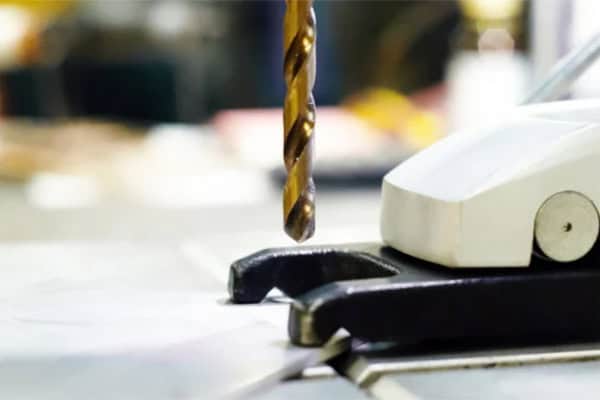
Understanding Drill Types for Stainless Steel
Choosing the right drill bit involves more than just picking an HSS bit. Here’s a detailed look at the different types of drill bits suitable for stainless steel:
| Drill Type | Best For | Características |
|---|---|---|
| High-Speed Steel (HSS6542 M2) | Stainless steel and other metals | Durable, heat-resistant, affordable |
| Cobalt Drill Bits (M35 & M42) | Harder metals like stainless steel | Contains cobalt for added strength and heat resistance, Amber color coating |
| Titanium-Coated HSS6542 (M2) | General metal drilling | Longer lifespan due to coating, less friction |
High-Speed Steel (HSS6542 M2) drill bits are a staple for metalworking. Their durability and resistance to heat make them suitable for a wide range of applications, including drilling into stainless steel. The HSS6542 (M2) variant offers enhanced performance due to its improved alloy composition, making it a reliable choice for both professionals and hobbyists.
Cobalt Drill Bits (M35 & M42) take things a step further by incorporating cobalt into the steel. This addition increases the bit’s hardness and heat resistance, allowing it to maintain sharpness longer and perform better under high-stress conditions. The M35 (5% cobalt) is often favored for its balance between performance and cost, while the M42 (8% cobalt) provides maximum durability for the toughest jobs.
Titanium-Coated HSS6542 (M2) bits offer a protective titanium nitride coating that reduces friction and extends the bit’s lifespan. While the base material is still HSS6542 (M2), the coating enhances performance, making these bits a versatile option for general metal drilling tasks.
Tips for Using HSS6542 (M2) and Cobalt Drills
To get the most out of your HSS6542 (M2) or cobalt drill bits, consider the following tips:
- Use Cutting Fluid: Applying cutting fluid reduces heat and friction, which are major culprits in bit wear and tear. It also helps in achieving a smoother finish on your holes.
- Maintain a Steady Speed: Drilling too fast can overheat the bit, causing it to dull quickly. On the other hand, drilling too slowly can lead to excessive friction and wear. Find a balanced speed that works best for your specific drill bit and material thickness.
- Apply Consistent Pressure: Avoid applying too much force, as it can cause the bit to break or wander off the mark. Let the drill bit do the work while you maintain steady, moderate pressure.
- Use a Pilot Hole: Starting with a smaller pilot hole can make drilling easier and more accurate, especially in thicker materials.
- Keep the Bit Sharp: Regularly inspect and sharpen your drill bits to maintain their cutting efficiency and prolong their lifespan.
By following these tips, you’ll ensure that your drill bits remain in top condition, providing you with clean and precise holes every time.
Can an HSS Drill Bit Cut Through Stainless Steel?
Absolutely, HSS drill bits can effectively cut through stainless steel when used correctly. Their high-speed steel composition is designed to handle the demands of drilling into hard materials, making them a reliable choice for stainless steel projects.
HSS6542 (M2) drill bits, along with cobalt variants like M35, are capable of drilling stainless steel efficiently. Ensuring the bit is sharp and using the right speed and lubrication makes all the difference. A dull bit can cause overheating2, leading to premature wear and poor-quality holes, while the right lubrication minimizes friction and keeps the bit cool.
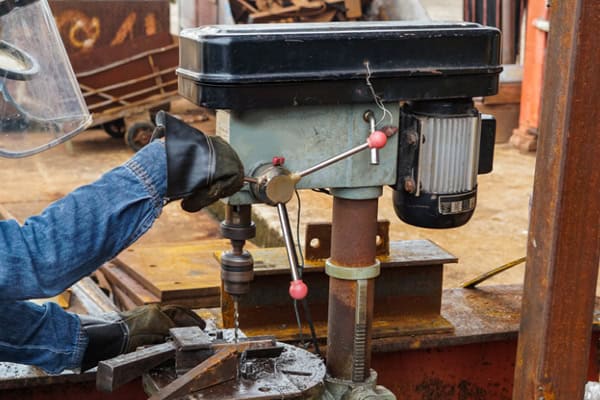
Maintaining HSS and Cobalt Drill Bits
Proper maintenance extends the life of your drill bits and ensures consistent performance. Here are some essential maintenance practices:
- Keep Them Sharp: Regularly inspect your drill bits for dullness or damage. Sharpening them as needed helps maintain cutting efficiency and prevents unnecessary wear.
- Use Lubrication: Applying cutting oil or another suitable lubricant during drilling reduces heat and friction, which are critical factors in extending the life of your bits.
- Store Properly: Protect your bits from damage by storing them in a dry, organized space. Using a drill bit organizer or case can help keep them safe and easily accessible.
- Clean After Use: Remove any metal shavings or debris from the bits after drilling. This prevents buildup that can cause corrosion or affect the bit’s performance.
- Inspect Regularly: Before each use, check your drill bits for any signs of wear or damage. Replace any bits that show significant wear to ensure optimal performance.
By taking these maintenance steps, you’ll ensure that your HSS6542 (M2) and cobalt drill bits remain effective and reliable for all your stainless steel projects.
What is the Best Way to Cut/Drill Through Stainless Steel?
Drilling through stainless steel requires a methodical approach to achieve clean and precise results. Stainless steel’s toughness3 and resistance to corrosion make it a challenging material to work with, but with the right techniques, you can drill clean holes without compromising the integrity of the material.
The best way to drill stainless steel is to use the right drill bit, apply steady pressure, and keep the bit cool with lubrication. This combination minimizes heat buildup and prevents the bit from dulling too quickly, ensuring a smooth and efficient drilling process.
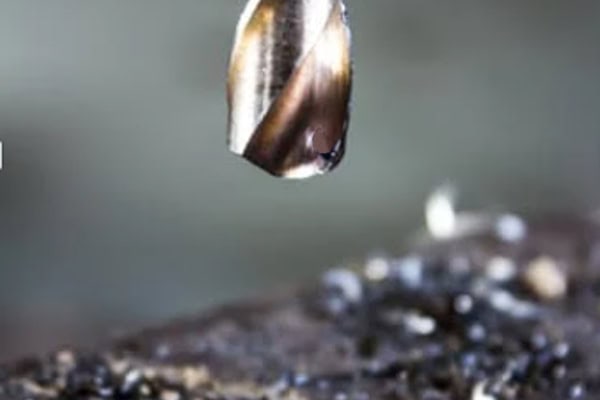
Step-by-Step Drilling Process
- Mark the Spot: Clearly mark where you want to drill. Use a center punch to create a small indentation, preventing the drill bit from wandering off the mark.
- Secure the Material: Clamp the stainless steel firmly to prevent movement during drilling. This ensures accuracy and safety.
- Apply Cutting Fluid: Lubricate the drilling area with cutting oil to reduce friction and heat. This helps in achieving a cleaner hole and prolongs the life of your drill bit.
- Start Drilling Slowly: Begin at a low speed to create a guide hole. This helps in maintaining control and accuracy.
- Increase Speed Gradually: Once the hole is established, gradually increase the drill speed. Maintaining a steady speed ensures even cutting and prevents overheating.
- Maintain Lubrication: Continuously apply cutting fluid as you drill to keep the bit cool and reduce friction.
- Finish the Hole: Once you’ve drilled through, withdraw the bit carefully while it’s still spinning. This helps in clearing any debris from the hole.
Following these steps ensures a smooth and efficient drilling process, resulting in clean and precise holes in your stainless steel material.
Common Mistakes to Avoid
- Using Dull Bits: Always use sharp drill bits to prevent overheating and ensure clean cuts. Dull bits can cause excessive friction, leading to poor-quality holes and increased wear.
- Applying Too Much Pressure: Let the drill bit do the work. Excessive force can cause the bit to break or the material to warp.
- Neglecting Lubrication: Cutting fluid is essential for reducing heat and extending bit life. Skipping this step can lead to premature bit dulling and poor drilling results.
- Drilling at the Wrong Angle: Maintain a perpendicular angle to the material to ensure straight and accurate holes.
- Not Securing the Material Properly: Movement during drilling can cause inaccuracies and potential safety hazards. Always clamp the material securely.
- Ignoring Safety Precautions: Always wear appropriate safety gear, such as gloves and eye protection, to prevent injuries from metal shavings and debris.
By avoiding these common mistakes, you’ll achieve better results and prolong the lifespan of your tools, making your stainless steel drilling projects more efficient and successful.
Can You Put Oil on a Stainless Steel Drill Bit?
Yes, applying oil to your drill bit is highly recommended when drilling stainless steel. Lubrication plays a crucial role in the drilling process, especially when working with tough materials like stainless steel.
Using oil as a lubricant helps reduce friction and heat, which are critical factors when drilling stainless steel. This not only prolongs the life of your drill bit but also ensures a cleaner and more precise hole. Without proper lubrication, the drill bit can overheat, leading to dulling and potential breakage, which compromises the quality of your work.
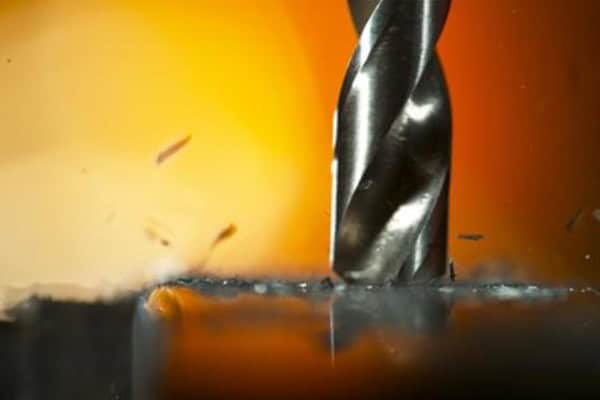
Types of Lubricants
Different lubricants can be used based on your specific needs and the nature of your drilling project. Here’s a breakdown of common lubricants4 suitable for drilling stainless steel:
- Cutting Oil: Ideal for most drilling tasks, cutting oil provides excellent lubrication and cooling properties. It’s designed to withstand high temperatures and reduce friction, making it perfect for stainless steel.
- WD-40: While not as effective as specialized cutting fluids, WD-40 can be used in a pinch. It offers basic lubrication and corrosion protection but may not provide the same level of performance as dedicated cutting oils.
- Machine Oil: Suitable for heavy-duty drilling applications, machine oil offers robust lubrication and can handle the demands of drilling through tough materials like stainless steel.
- Synthetic Lubricants: These offer superior lubrication and cooling properties, often outperforming traditional oils. They can be a bit pricier but are worth the investment for frequent or demanding drilling tasks.
- Graphite Lubricants: These provide a dry lubrication option, which can be beneficial in environments where liquid lubricants might attract dust or debris.
Choosing the right lubricant enhances drilling performance, reduces wear on your drill bits, and ensures a smoother, more efficient drilling process.
How to Apply Lubricant
Proper application of lubricant is essential to maximize its benefits. Here’s how to effectively apply lubricant during the drilling process:
- Before Drilling: Apply a generous amount of cutting oil to the drill bit. This initial lubrication helps reduce friction from the start, making it easier to penetrate the stainless steel.
- During Drilling: Reapply lubricant periodically as you drill. This ensures continuous cooling and lubrication, preventing the bit from overheating and maintaining its cutting efficiency.
- After Drilling: Clean the drill bit thoroughly to remove any residual oil and metal shavings. This prevents corrosion and prepares the bit for future use.
- Use a Lubrication Method: Depending on your setup, you can apply lubricant manually with a brush or use a drip-feed system that continuously supplies lubricant to the drilling area.
- Monitor Lubrication Levels: Keep an eye on the lubricant levels during drilling. If you notice the drilling area becoming dry, pause and reapply lubricant to maintain optimal conditions.
By following these application methods, you’ll ensure that your drill bits remain cool and well-lubricated, enhancing their performance and longevity.
The Difference Between HSS and Cobalt Drill Bits
Understanding the differences between HSS5 and cobalt drill bits can help you choose the right tool for your stainless steel projects. Each type of drill bit has its own set of advantages and ideal use cases, making them suitable for different tasks and materials.
HSS6542 (M2) drill bits are made from high-speed steel, suitable for general metal drilling, while cobalt drill bits (M35 & M42) contain cobalt, making them harder and more heat-resistant. This makes cobalt bits better for prolonged use in tough materials like stainless steel, offering enhanced durability and performance under demanding conditions.
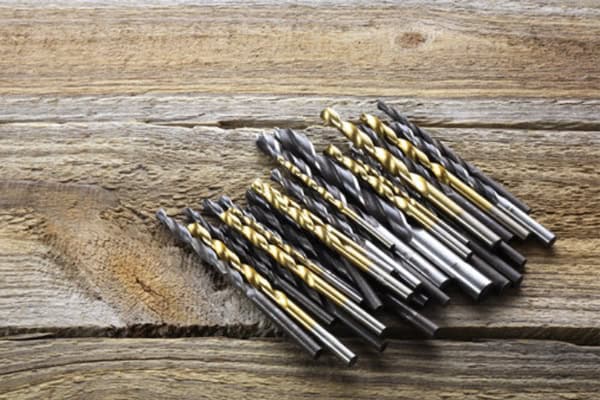
Comparing HSS6542 (M2) and Cobalt Bits
| Rasgo | HSS6542 (M2) Drill Bits | Cobalt Drill Bits (M35 & M42) |
|---|---|---|
| Material | High-speed steel (HSS6542 M2) | High-speed steel with 5-8% cobalt |
| Durabilidad | Good for general use | Superior durability for hard metals |
| Heat Resistance | Moderate | High |
| Costo | More affordable | More expensive |
| Best For | Light to medium drilling tasks | Heavy-duty drilling in hard materials |
| Surface Treatment | None or titanium-coated | Amber color coating |
Material: HSS6542 (M2) bits are crafted from high-speed steel, which offers good durability and heat resistance for general drilling tasks. Cobalt bits, on the other hand, incorporate cobalt into the steel alloy, significantly enhancing their hardness and ability to withstand high temperatures.
Durability: While HSS6542 (M2) bits are durable enough for most metalworking tasks, cobalt bits excel in longevity, especially when drilling into tough materials like stainless steel. They maintain their sharpness longer, reducing the need for frequent replacements.
Heat Resistance: Cobalt bits have superior heat resistance compared to HSS6542 (M2) bits. This makes them ideal for prolonged drilling sessions where heat buildup is a concern, ensuring that the bit remains effective and doesn’t dull quickly.
Cost: HSS6542 (M2) bits are generally more affordable, making them a cost-effective choice for everyday drilling tasks. Cobalt bits are pricier due to their enhanced properties, but the investment pays off in terms of durability and performance, especially for heavy-duty applications.
Best For: HSS6542 (M2) bits are suitable for light to medium drilling tasks in various metals, including stainless steel. Cobalt bits are best reserved for heavy-duty drilling in harder materials, where their superior performance justifies the higher cost.
Surface Treatment: While HSS6542 (M2) bits may come with or without a coating, cobalt bits often feature an amber color coating. This not only helps in identifying them but also provides additional protection against heat and wear.
When to Choose Cobalt Drill Bits
Opt for cobalt bits when:
- Drilling Frequently in Stainless Steel: Their ability to maintain sharpness makes them ideal for repetitive tasks, saving you time and money in the long run.
- Working on Thick or Hard Materials: The added strength of cobalt is beneficial when dealing with tougher materials, ensuring clean and precise holes.
- Precision is Critical: Cobalt bits provide cleaner and more accurate holes, which is essential for projects requiring high precision.
- Long-Term Use: If you need a drill bit that can withstand prolonged use without degrading, cobalt bits are the way to go.
- High-Volume Production: In industrial settings where drilling is a frequent task, cobalt bits offer the durability and performance needed to keep up with demand.
Investing in cobalt drill bits can save time and money in the long run for demanding projects, providing consistent performance and reducing the frequency of bit replacements.
What is the Best Drill Bit Type to Drill into 2mm Stainless Steel?
Drilling into 2mm stainless steel requires precision and the right tool to ensure a clean hole without damaging the material. Thin materials like 2mm stainless steel are prone to warping6 and tearing, making the choice of drill bit and technique crucial.
A cobalt drill bit (preferably M35) is the best type for drilling into 2mm stainless steel. Its superior hardness and heat resistance make it ideal for creating precise and clean holes in thin stainless steel sheets. The M35 variant offers an optimal balance between performance and cost, making it a practical choice for both professionals and hobbyists.
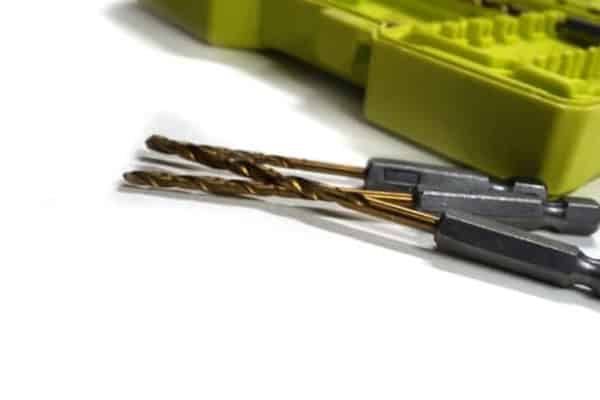
Benefits of Using Cobalt Bits for Thin Materials
- Enhanced Durability: Cobalt bits resist wear and tear better, preventing premature dulling even when drilling multiple holes in thin materials.
- Clean Cuts: The precision of cobalt bits reduces the risk of tearing or warping the stainless steel, ensuring neat and accurate holes.
- Efficiency: These bits drill faster with less effort required, making the process quicker and more efficient.
- Heat Management: Their ability to dissipate heat effectively minimizes the chances of overheating, which is crucial when working with thin materials that can easily warp.
- Versatility: While ideal for stainless steel, cobalt bits can handle a variety of other hard metals, providing flexibility for different projects.
Using the right bit ensures that even thin materials are handled with care and precision, maintaining the integrity of your workpiece.
Technique for Drilling Thin Stainless Steel
- Secure the Sheet: Use clamps to hold the 2mm stainless steel firmly in place. This prevents movement and ensures that the drill bit remains steady during the drilling process.
- Mark the Drilling Point: Clearly mark where the hole is needed using a center punch. This creates a small indentation that helps guide the drill bit and prevents it from wandering.
- Start with a Pilot Hole: Use a smaller bit to create a guide hole. This step helps in maintaining accuracy and reduces the strain on the larger bit.
- Switch to the Cobalt Bit: Drill through the pilot hole with the cobalt bit for a cleaner and more precise finish. The smaller pilot hole makes it easier for the larger bit to follow the correct path.
- Apply Steady Pressure: Avoid bending or warping the thin sheet by applying consistent, moderate pressure. Let the drill bit do the work without forcing it, which can help prevent damage to both the bit and the material.
- Maintain Lubrication: Continuously apply cutting fluid to keep the bit cool and reduce friction. This ensures a smoother drilling process and prolongs the life of your drill bit.
- Finish the Hole: Once through, withdraw the bit carefully while it’s still spinning. This helps in clearing any debris from the hole and prevents the material from tearing.
By following these techniques, you can maintain the integrity of the stainless steel while achieving the desired hole with precision and efficiency.
¿Merecen la pena las brocas de cobalto?
Investing in cobalt drill bits can be highly beneficial, especially for those who frequently work with stainless steel or other hard materials7. While they come with a higher price tag compared to standard HSS bits, the benefits they offer often justify the investment.
Cobalt drill bits are worth the investment if you regularly work with stainless steel or other hard materials. Their durability and performance justify the higher cost by reducing the need for frequent replacements and providing superior drilling quality. For professionals and serious hobbyists, the enhanced performance and longevity make cobalt bits a valuable addition to any toolkit.
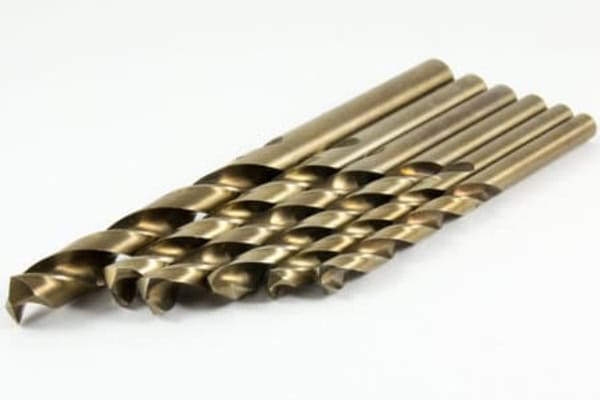
Long-Term Benefits of Cobalt Bits
- Cost-Effective Over Time: Although the initial investment is higher, cobalt bits last significantly longer than standard HSS bits. This reduces the frequency of replacements, leading to savings in the long run.
- Consistent Performance: Cobalt bits maintain their sharpness and efficiency even after prolonged use, ensuring that your drilling tasks are completed with high precision every time.
- Versatility: Suitable for a wide range of materials beyond stainless steel, including cast iron, titanium, and other hard metals. This versatility makes them a practical choice for various projects.
- Reduced Downtime: With their enhanced durability, cobalt bits require less maintenance and fewer replacements, minimizing downtime and keeping your projects on schedule.
- Enhanced Safety: Durable bits are less likely to break or shatter during drilling, reducing the risk of accidents and ensuring a safer working environment.
The reliability and performance of cobalt bits make them a valuable investment for those who demand high-quality results and long-lasting tools.
User Experiences
Many professionals and hobbyists have found that cobalt bits significantly improve their drilling experience:
- Reduced Frustration: Less bit breakage and overheating means fewer interruptions and a smoother workflow.
- Better Results: Cleaner and more accurate holes every time enhance the quality of your projects and reduce the need for rework.
- Increased Productivity: Faster drilling with fewer interruptions for bit changes allows for more efficient project completion.
- Versatile Applications: Users appreciate the ability to switch between different materials without needing multiple sets of drill bits.
- Enhanced Confidence: Knowing that your drill bits can handle tough materials with ease gives you the confidence to tackle more challenging projects.
These positive experiences highlight the practical advantages of using cobalt drill bits, making them a preferred choice for many in the industry.
How to Identify a Cobalt Drill Bit?
Identifying a cobalt drill bit ensures you’re using the right tool for your stainless steel projects. Proper identification helps in selecting the appropriate bit, enhancing both efficiency8 and results.
Cobalt drill bits are usually marked with an amber color and may have "Co" stamped on the shank. These markings help distinguish them from standard HSS bits, making it easier to identify them in your collection.
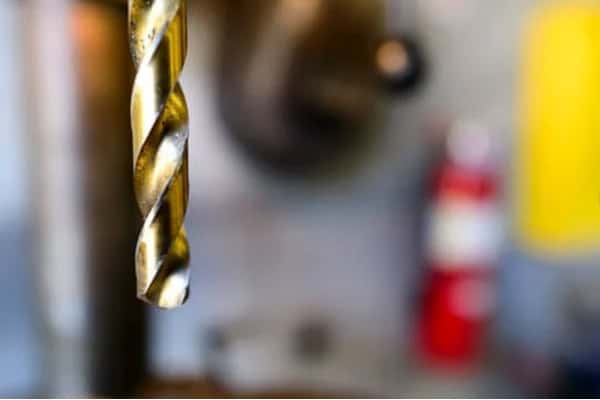
Visual Indicators
- Color Coding: Many cobalt bits have a distinctive amber coating. This not only makes them easy to identify but also provides additional protection against heat and wear.
- Markings: Look for "Co" or "Cobalt" engraved on the bit. These markings are often found near the shank and serve as a clear indicator of the bit’s composition.
- Shank Design: Cobalt bits often feature a slightly different shank design compared to standard HSS bits. This design enhances heat resistance and ensures better performance during drilling.
- Finish: The overall finish of cobalt bits tends to be more polished, reducing friction and improving the drilling process.
These visual cues make it easier to select the correct bit from your collection, ensuring that you’re using the right tool for the job.
Verifying with Specifications
- Check Packaging: Manufacturers typically label cobalt bits clearly. Look for packaging that specifies the percentage of cobalt (e.g., M35 with 5% cobalt or M42 with 8% cobalt).
- Material Composition: Ensure the bit contains a percentage of cobalt, usually between 5-8%. This information is often listed in the product specifications or on the packaging.
- Manufacturer’s Guide: Refer to the product specifications to confirm the bit’s composition and suitability for drilling stainless steel. Reputable manufacturers provide detailed information about their products.
Accurate identification helps ensure you’re using the right tool for the job, enhancing both efficiency and results. Always double-check the specifications and markings before making a purchase to guarantee that the drill bit meets your project’s requirements.
Enhancing Your Drilling Techniques
Mastering the art of drilling stainless steel involves more than just choosing the right drill bit. Enhancing your drilling techniques can lead to more efficient, accurate, and safer projects9. Here are some advanced tips and strategies to take your drilling skills to the next level.
Pre-Drilling Preparations
Before you start drilling, proper preparation is essential to ensure the best results:
- Material Inspection: Examine the stainless steel for any existing flaws, such as cracks or dents, that might affect the drilling process.
- Marking Tools: Use a center punch and hammer to create a small indentation at the drilling point. This helps in guiding the drill bit and preventing it from wandering.
- Drill Speed Selection: Choose the appropriate drill speed based on the material thickness and drill bit type. Generally, lower speeds are better for harder materials like stainless steel.
- Tool Alignment: Ensure that the drill is perpendicular to the material to achieve straight and accurate holes.
Advanced Drilling Techniques
- Incremental Drilling: Start with a smaller pilot hole and gradually increase the size. This reduces stress on the drill bit and improves accuracy.
- Back Drilling: Drilling from both sides of the material can help in reducing tear-out and achieving a cleaner hole.
- Controlled Withdrawal: Slowly withdrawing the drill bit while it’s still spinning can help in clearing out debris and preventing overheating.
- Use of Drill Press: For maximum precision, consider using a drill press. This tool provides better control over speed and alignment, ensuring consistent results.
Cooling and Lubrication Strategies
Effective cooling and lubrication are critical for maintaining drill bit performance and prolonging their lifespan:
- Continuous Lubrication: Use a drip-feed system to provide a steady supply of cutting fluid to the drilling area, ensuring consistent cooling.
- Intermittent Drilling: Pause periodically to reapply cutting fluid, especially when drilling through thick materials, to prevent heat buildup.
- Cooling Breaks: Allow the drill bit to cool down between drilling sessions to avoid overheating and material warping.
- Proper Fluid Application: Apply cutting fluid directly to the drill bit and the drilling area, ensuring that both are adequately lubricated.
Post-Drilling Finishing
After drilling, proper finishing techniques can enhance the quality of your work:
- Deburring: Remove any sharp edges or burrs around the hole using a deburring tool or file. This ensures a smooth finish and reduces the risk of injury.
- Cleaning: Clean the drilled area with a solvent to remove any residual cutting fluid and metal shavings, preventing corrosion and ensuring a clean surface.
- Inspection: Check the hole for accuracy and quality, ensuring that it meets the project’s specifications. Make any necessary adjustments or refinements.
- Protective Coating: Consider applying a protective coating to prevent corrosion, especially if the drilled material will be exposed to harsh environments.
Safety Precautions
Drilling stainless steel involves handling powerful tools and materials, making safety a top priority:
- Personal Protective Equipment (PPE): Always wear safety goggles, gloves, and appropriate clothing to protect against metal shavings and debris.
- Secure Work Area: Ensure that your workspace is well-lit, clean, and free from hazards. Use clamps and supports to stabilize the material.
- Tool Maintenance: Regularly inspect and maintain your drill bits and equipment to ensure they are in good working condition, reducing the risk of accidents.
- Proper Handling: Handle drill bits with care to avoid injury. Always turn off and unplug power tools when changing bits or making adjustments.
- Ventilation: Work in a well-ventilated area to avoid inhaling metal dust and fumes generated during drilling.
By incorporating these advanced techniques and safety measures, you’ll enhance your drilling efficiency, achieve higher-quality results, and ensure a safer working environment.
Troubleshooting Common Drilling Issues
Even with the best tools and techniques10, you might encounter some challenges while drilling stainless steel. Understanding these common issues and knowing how to address them can save you time and frustration.
Bit Wandering
Problem: The drill bit slips or moves away from the marked drilling point, leading to inaccurate holes.
Solutions:
- Use a Center Punch: Create a small indentation at the drilling point to guide the drill bit and prevent it from wandering.
- Start with a Pilot Hole: Use a smaller bit to create a guide hole before switching to the desired size, ensuring better accuracy.
- Secure the Material: Clamp the stainless steel firmly to prevent movement during drilling.
- Use a Drill Press: For maximum precision, a drill press can help maintain proper alignment and prevent bit wandering.
Calentamiento excesivo
Problem: The drill bit becomes excessively hot, leading to dulling and reduced performance.
Solutions:
- Apply Cutting Fluid: Use cutting oil to reduce friction and dissipate heat, keeping the drill bit cool.
- Maintain a Steady Speed: Avoid drilling too fast, which can cause overheating. Find a balanced speed that works best for your bit and material thickness.
- Take Breaks: Allow the drill bit to cool down between drilling sessions to prevent heat buildup.
- Use the Right Bit: Ensure you are using a drill bit designed for stainless steel, such as HSS6542 (M2) or cobalt bits, which have better heat resistance.
Bit Breakage
Problem: The drill bit breaks or shatters during drilling, causing frustration and potential safety hazards.
Solutions:
- Use Sharp Bits: Dull drill bits are more prone to breaking. Regularly sharpen or replace your bits to maintain cutting efficiency.
- Apply Consistent Pressure: Avoid applying too much force, which can cause the bit to snap. Let the drill bit do the work with steady, moderate pressure.
- Secure the Material: Clamp the stainless steel firmly to prevent movement that can lead to bit breakage.
- Use Proper Drilling Techniques: Follow proper drilling procedures, such as starting with a pilot hole and maintaining the correct speed, to reduce stress on the bit.
Poor Hole Quality
Problem: The drilled holes are rough, uneven, or have burrs, compromising the quality of your project.
Solutions:
- Use Cutting Fluid: Proper lubrication helps achieve cleaner cuts and reduces the likelihood of burrs.
- Maintain Bit Sharpness: Regularly inspect and sharpen your drill bits to ensure smooth and precise drilling.
- Control Drilling Speed: Use an appropriate speed to avoid excessive heat and friction, which can affect hole quality.
- Finish with Deburring: After drilling, use a deburring tool or file to remove any sharp edges or roughness around the hole, ensuring a smooth finish.
Material Warping
Problem: The stainless steel material warps or bends during drilling, especially when working with thin sheets.
Solutions:
- Use Clamps: Secure the material firmly with clamps to prevent movement and warping during drilling.
- Apply Steady Pressure: Avoid applying excessive force, which can cause the material to bend. Use consistent, moderate pressure to maintain control.
- Use a Backing Support: Place a backing material behind the stainless steel to provide support and prevent warping as you drill through.
- Drill Slowly: Use a lower speed to reduce heat and stress on the material, minimizing the risk of warping.
By understanding and addressing these common drilling issues, you can improve the quality of your work, enhance your drilling efficiency, and create more professional and precise results.
Optimizing Drill Bit Performance
Maximizing the performance of your drill bits ensures that you get the best results from your drilling projects. Proper usage, maintenance11, and optimization techniques can significantly enhance the longevity and efficiency of your drill bits.
Proper Bit Alignment
Ensuring that your drill bit is properly aligned with your drill and the material is crucial for accurate drilling:
- Use a Drill Guide: A drill guide helps maintain the correct angle and alignment, preventing the bit from slipping or wandering.
- Check Drill Alignment: Before starting, ensure that the drill is perpendicular to the material to achieve straight and accurate holes.
- Secure the Bit: Make sure the drill bit is securely tightened in the chuck to prevent wobbling or misalignment during drilling.
Enhancing Bit Longevity
Prolonging the life of your drill bits reduces the need for frequent replacements and saves you money:
- Use Cutting Fluid: Regular application of cutting fluid reduces friction and heat, preventing premature dulling and wear.
- Avoid Overheating: Drilling at the correct speed and applying steady pressure helps prevent overheating, which can degrade the bit’s performance.
- Store Properly: Keep your drill bits in a dry, organized space to protect them from damage and corrosion.
- Sharpen Regularly: Regularly inspect and sharpen your bits to maintain their cutting efficiency and extend their lifespan.
Increasing Drilling Efficiency
Enhancing your drilling techniques can lead to faster and more efficient drilling sessions:
- Use the Right Speed: Adjust the drill speed based on the material thickness and drill bit type to optimize drilling performance.
- Maintain Consistent Pressure: Apply steady, moderate pressure to ensure even cutting and prevent bit breakage.
- Use Pilot Holes: Starting with a smaller pilot hole can make drilling easier and more accurate, especially in thicker materials.
- Clear Debris: Regularly remove metal shavings and debris from the drilling area to prevent clogging and maintain cutting efficiency.
Utilizing Drill Bit Accessories
Accessories can enhance the performance and versatility of your drill bits:
- Drill Bit Extensions: These allow you to reach deeper or more confined areas, expanding the range of your drilling capabilities.
- Pilot Hole Guides: These guides help in creating accurate pilot holes, ensuring better alignment and precision.
- Deburring Tools: These tools help in removing burrs and sharp edges after drilling, ensuring a smooth and clean finish.
- Lubrication Systems: Automated lubrication systems provide a steady supply of cutting fluid, maintaining optimal drilling conditions.
By optimizing your drill bit performance through proper alignment, maintenance, and the use of accessories, you can achieve more efficient and high-quality drilling results, enhancing the overall success of your projects.
Advanced Drill Bit Technologies
The evolution of drill bit technologies has introduced new materials, coatings12, and designs that enhance performance and durability. Understanding these advancements can help you choose the best drill bits for your stainless steel projects.
Coated Drill Bits
Coatings on drill bits provide additional protection and enhance their performance:
- Titanium Nitride (TiN): A common coating that reduces friction and increases hardness, extending the life of the drill bit.
- Titanium Carbonitride (TiCN): Offers even better hardness and heat resistance than TiN, suitable for more demanding drilling tasks.
- Black Oxide: Provides corrosion resistance and reduces friction, making it ideal for general metal drilling.
Titanium-coated HSS6542 (M2) bits, as mentioned earlier, benefit from a titanium nitride coating that enhances their longevity and reduces friction during drilling.
Specialized Drill Bits
For specific drilling needs, specialized drill bits offer tailored performance:
- Step Drill Bits: Ideal for creating holes of varying sizes without changing bits, saving time and increasing efficiency.
- Spade Bits: Designed for drilling large, flat-bottomed holes in wood, but some variants can be used on softer metals with caution.
- Hole Saws: Perfect for cutting large diameter holes, offering clean and precise cuts in stainless steel and other metals.
Cobalt Alloy Enhancements
Cobalt drill bits themselves have seen advancements in alloy composition, enhancing their performance:
- Higher Cobalt Content: Some bits now incorporate higher percentages of cobalt (up to 8%), further increasing their hardness and heat resistance.
- Advanced Alloy Formulations: Manufacturers are continuously developing new alloy formulations that improve durability, reduce brittleness, and enhance overall performance.
Innovative Designs
Modern drill bits feature innovative designs that improve their functionality and ease of use:
- Split Point Tips: These tips start drilling instantly without the need for a pilot hole, reducing the chances of bit wandering.
- Flute Designs: Enhanced flute designs improve chip evacuation, reducing the risk of clogging and overheating.
- Self-Clearing Flutes: These flutes help in clearing debris more efficiently, maintaining cutting efficiency and reducing heat buildup.
By staying informed about advanced drill bit technologies, you can select the best tools for your stainless steel drilling projects, ensuring optimal performance and longevity.
Personal Protective Equipment (PPE)
Wearing the right PPE protects you from potential hazards associated with drilling stainless steel:
- Safety Goggles: Protect your eyes from flying metal shavings and debris.
- Gloves: Wear gloves to protect your hands from sharp edges and heat.
- Hearing Protection: Use earplugs or earmuffs to protect your hearing from loud drilling noises.
- Protective Clothing: Wear long sleeves and pants to shield your skin from metal fragments and sparks.
- Respirators or Masks: Use masks to prevent inhalation of metal dust and fumes, especially in poorly ventilated areas.
Safe Drilling Practices
Adhering to safe drilling practices minimizes the risk of accidents and ensures a smooth workflow:
- Secure the Workpiece: Always clamp the stainless steel firmly to prevent movement during drilling, reducing the risk of bit breakage and injuries.
- Check Equipment: Inspect your drill and bits for any signs of wear or damage before use. Replace any compromised tools to maintain safety.
- Use Proper Techniques: Follow correct drilling techniques, such as maintaining a perpendicular angle and applying steady pressure, to ensure control and accuracy.
- Stay Focused: Avoid distractions while drilling to maintain control over the tool and prevent accidents.
- Clear the Area: Keep your workspace clean and free from clutter to reduce trip hazards and ensure easy access to tools and materials.
Tool Maintenance and Inspection
Regular maintenance and inspection of your drilling tools enhance safety and performance:
- Sharpen Bits Regularly: Sharp drill bits reduce the risk of breakage and ensure smoother drilling, preventing unexpected tool failures.
- Lubricate Properly: Proper lubrication not only improves drilling efficiency but also prevents overheating and potential tool damage.
- Store Tools Safely: Keep your drill bits and tools organized and stored in a safe manner to prevent accidents and tool damage.
- Replace Damaged Bits: Discard any bits that show signs of cracking, chipping, or excessive wear to maintain safe and effective drilling operations.
Emergency Preparedness
Being prepared for emergencies ensures that you can respond effectively in case of accidents:
- First Aid Kit: Keep a well-stocked first aid kit accessible in your workspace to handle minor injuries promptly.
- Fire Extinguisher: Have a fire extinguisher nearby, especially if you’re working with flammable lubricants or materials.
- Training: Ensure that you and anyone assisting you are trained in basic first aid and know how to respond to common drilling-related emergencies.
- Clear Exits: Maintain clear and unobstructed exit paths in your workspace to allow for quick evacuation if needed.
By following these safety measures, you can create a secure and efficient drilling environment, minimizing the risk of accidents and ensuring a successful project outcome.
Maximizing Precision in Drilling
Achieving precision in drilling stainless steel13 is crucial for the quality and functionality of your projects. Precision ensures that the holes are accurately placed, the right size, and cleanly finished, which is essential for both aesthetic and structural integrity.
Importance of Precision
Precision in drilling stainless steel affects various aspects of your project:
- Structural Integrity: Accurate holes ensure that fasteners fit correctly, maintaining the strength and stability of the assembly.
- Aesthetic Quality: Clean and precise holes enhance the overall appearance of the finished product, giving it a professional look.
- Functionality: Properly drilled holes allow for smooth operation of mechanical parts, ensuring that they perform as intended.
- Material Efficiency: Precision drilling minimizes waste and reduces the risk of damaging the material, leading to cost-effective and sustainable practices.
Techniques for Achieving Precision
Implementing the right techniques can significantly improve drilling precision:
- Use a Drill Press: A drill press provides better control over speed and alignment, ensuring consistent and accurate holes compared to handheld drills.
- Pilot Holes: Starting with a smaller pilot hole helps guide the larger bit, enhancing accuracy and reducing the risk of bit wandering.
- Clamping: Securely clamping the stainless steel prevents movement, ensuring that the drill bit follows the marked drilling point accurately.
- Steady Hand: Maintain a steady hand and consistent pressure throughout the drilling process to achieve straight and even holes.
- Center Punch: Using a center punch to create an indentation at the drilling point helps guide the bit and maintain precision.
Utilizing Guides and Jigs
Guides and jigs are invaluable tools for enhancing drilling precision:
- Drill Guides: These tools help maintain the correct angle and alignment of the drill bit, ensuring straight and accurate holes.
- Jigs: Custom jigs can be designed to hold the material in place and guide the drill bit, improving consistency across multiple holes.
- Templates: Templates with pre-marked drilling points provide a visual guide, enhancing accuracy and repeatability.
- Self-Centering Drill Bits: These bits have a tip that centers itself in the pilot hole, maintaining alignment and improving precision.
Measuring and Marking Accuracy
Accurate measurement and marking are foundational to precise drilling:
- Use Accurate Measuring Tools: Calipers, rulers, and angle finders help in measuring and marking the exact drilling points.
- Mark Clearly: Use a fine-tip marker or center punch to create clear and precise marks on the stainless steel, ensuring the drill bit follows the intended path.
- Double-Check Measurements: Verify your measurements before drilling to prevent mistakes and ensure that the holes are correctly placed.
- Consistent Spacing: When drilling multiple holes, maintain consistent spacing to ensure uniformity and balance in the finished product.
Finishing Techniques for Precision
Post-drilling finishing techniques enhance the precision and quality of your holes:
- Deburring: Removing burrs and sharp edges around the hole ensures a smooth finish and prevents injuries or material damage.
- Chamfering: Adding a slight chamfer to the hole edges can improve the appearance and functionality, especially when inserting fasteners.
- Polishing: Polishing the drilled holes removes any roughness, enhancing the aesthetic quality and ensuring a professional finish.
- Inspection: Use precision measuring tools to inspect the holes, ensuring they meet the required specifications and are free from defects.
By implementing these precision-enhancing techniques, you’ll achieve high-quality results in your stainless steel drilling projects, ensuring that your work is both functional and aesthetically pleasing.
Advanced Applications of Stainless Steel Drilling
Drilling stainless steel isn’t just about creating holes; it’s about enabling a wide range of applications14 that enhance the functionality and versatility of your projects. Here are some advanced applications that showcase the importance and benefits of precise stainless steel drilling.
Custom Fabrication
Custom fabrication involves creating unique and specialized components tailored to specific needs. Drilling stainless steel plays a crucial role in this process:
- Industrial Components: Drilling precise holes in stainless steel is essential for manufacturing machinery parts, fittings, and frames, ensuring proper assembly and functionality.
- Architectural Elements: Custom-fabricated stainless steel pieces, such as railings, staircases, and decorative panels, require accurate drilling to achieve the desired design and structural integrity.
Industrial Maintenance and Repairs
In industrial settings, stainless steel drilling is essential for maintenance and repair tasks:
- Equipment Repair: Drilling is often required to repair or modify machinery components, ensuring continued functionality and extending equipment lifespan.
- Installation of Accessories: Adding accessories like mounts, brackets, and handles to industrial equipment involves precise drilling to ensure secure attachment and proper alignment.
- Fabrication of Replacement Parts: Creating replacement parts for broken or worn-out components requires accurate drilling to match the original specifications and maintain performance.
- Customization for Upgrades: Drilling allows for customization and upgrades of industrial equipment, enhancing functionality and adapting to changing needs.
These advanced applications demonstrate the versatility and importance of stainless steel drilling in various industries, highlighting its role in enhancing functionality, precision, and aesthetic appeal across a wide range of projects.
Exploring Alternative Materials and Their Drilling Requirements
While stainless steel is a popular and versatile material, understanding the drilling requirements of alternative materials15 can broaden your skill set and project capabilities. Each material has its own characteristics and challenges, requiring specific drill bits and techniques to achieve optimal results.
Aluminio
Properties:
- Lightweight and malleable
- Resistente a la corrosión
- Softer than stainless steel
Drilling Requirements:
- Drill Bits: High-speed steel (HSS) or cobalt bits work well. For cleaner holes, consider using bits with a split point design.
- Speed and Pressure: Use a higher drilling speed compared to stainless steel, with moderate pressure to prevent bit wandering.
- Lubrication: While not always necessary, using cutting fluid can extend bit life and improve hole quality.
- Cooling: Aluminum dissipates heat quickly, reducing the need for continuous cooling.
Titanio
Properties:
- Extremely strong and lightweight
- Highly corrosion-resistant
- Difficult to machine
Drilling Requirements:
- Drill Bits: Cobalt bits are preferred due to their superior hardness and heat resistance. Specialized titanium drill bits are also available.
- Speed and Pressure: Use lower drilling speeds to prevent overheating, with steady, consistent pressure.
- Lubrication: Cutting fluid is essential to reduce friction and heat buildup, prolonging bit life.
- Cooling: Continuous lubrication helps manage heat effectively, preventing bit dulling and material damage.
Hierro fundido
Properties:
- Brittle yet strong
- Excellent wear resistance
- Prone to cracking under stress
Drilling Requirements:
- Drill Bits: Cobalt or carbide-tipped bits are ideal for handling the hardness and brittleness of cast iron.
- Speed and Pressure: Use low drilling speeds with firm, steady pressure to prevent cracking and ensure clean cuts.
- Lubrication: Cutting fluid helps reduce friction and heat, minimizing the risk of bit wear and material damage.
- Cooling: Effective cooling is crucial to maintain bit sharpness and prevent overheating.
Latón
Properties:
- Soft and malleable
- Highly ductile
- Excellent electrical conductivity
Drilling Requirements:
- Drill Bits: High-speed steel (HSS) bits or cobalt bits with a split point design are suitable for brass.
- Speed and Pressure: Use higher drilling speeds with light to moderate pressure to avoid deformation and achieve smooth holes.
- Lubrication: While brass doesn’t require as much lubrication as harder metals, using a light lubricant can improve hole quality and extend bit life.
- Cooling: Minimal cooling is needed due to brass’s good thermal conductivity, but occasional lubrication helps maintain bit performance.
Acero carbono
Properties:
- Strong and durable
- Less corrosion-resistant than stainless steel
- Hardness varies based on composition
Drilling Requirements:
- Drill Bits: High-speed steel (HSS) or cobalt bits are effective, especially for harder grades of carbon steel.
- Speed and Pressure: Adjust drilling speed based on hardness; harder steels require slower speeds with steady pressure.
- Lubrication: Cutting fluid is recommended to reduce heat and friction, prolonging bit life and improving hole quality.
- Cooling: Proper cooling techniques help manage heat buildup, preventing bit dulling and material deformation.
Cobre
Properties:
- Soft and malleable
- Excellent electrical and thermal conductivity
- Prone to galling and sticking
Drilling Requirements:
- Drill Bits: High-speed steel (HSS) bits with a split point design minimize bit wandering and ensure clean holes.
- Speed and Pressure: Use higher drilling speeds with light pressure to prevent bit sticking and material deformation.
- Lubrication: Essential to reduce friction and prevent galling, ensuring smooth drilling and extended bit life.
- Cooling: Continuous lubrication helps manage heat and maintain bit sharpness, enhancing drilling efficiency.
Summary Table
| Material | Recommended Drill Bits | Velocidad | Presión | Lubrication | Enfriamiento |
|---|---|---|---|---|---|
| Aluminio | HSS or cobalt, split point design | Higher speed | Moderate pressure | Optional cutting fluid | Minimal cooling needed |
| Titanio | Cobalt or specialized titanium | Lower speed | Steady pressure | Essential cutting fluid | Continuous lubrication necessary |
| Hierro fundido | Cobalt or carbide-tipped | Low speed | Firm pressure | Essential cutting fluid | Effective cooling required |
| Latón | HSS, split point design | Higher speed | Light to moderate | Light lubricant optional | Minimal cooling needed |
| Acero carbono | HSS4241 o HSS4341 | Varies by hardness | Steady pressure | Recommended cutting fluid | Proper cooling techniques required |
| Cobre | HSS, split point design | Higher speed | Light pressure | Essential cutting fluid | Continuous lubrication necessary |
Understanding the unique drilling requirements of each material allows you to select the appropriate drill bits and techniques, ensuring optimal performance and high-quality results across a wide range of projects.
Innovative Drilling Solutions
As technology advances, so do the tools and techniques available for drilling stainless steel. Innovative solutions are enhancing drilling efficiency, precision, and safety16, making it easier to tackle complex projects with confidence.
Cordless Drills with Advanced Features
Cordless drills have become increasingly sophisticated, offering features that enhance their performance and versatility:
- Brushless Motors: Provide higher efficiency, longer runtime, and increased durability compared to traditional brushed motors.
- Variable Speed Controls: Allow for precise adjustment of drilling speed based on the material and task, improving accuracy and reducing bit wear.
- Torque Settings: Adjustable torque settings prevent overdriving screws and bits, enhancing control and precision.
- Ergonomic Designs: Improved grip and lightweight construction reduce fatigue and increase comfort during extended drilling sessions.
- Battery Technology: Advances in lithium-ion batteries offer longer run times, faster charging, and lighter weights, making cordless drills more powerful and convenient.
Smart Drill Systems
Smart drill systems incorporate technology to provide enhanced functionality and ease of use:
- Integrated Sensors: Monitor drill bit position, speed, and temperature, providing real-time feedback to optimize drilling performance.
- Automatic Speed Adjustment: Adjust drilling speed automatically based on the material and bit condition, ensuring consistent results.
- Digital Displays: Provide detailed information about drilling parameters, helping users maintain control and precision.
- Programmable Settings: Allow users to save and recall specific drilling settings for different materials and tasks, increasing efficiency and consistency.
- Connectivity Features: Some smart drills can connect to smartphones or other devices, enabling remote control and monitoring through dedicated apps.
These advanced features make smart drill systems a valuable tool for both professionals and hobbyists, enhancing drilling accuracy and efficiency while reducing the risk of errors and accidents.
High-Precision Drill Presses
Modern drill presses offer advanced features that improve drilling precision and control:
- Digital Controls: Provide precise speed and depth adjustments, allowing for accurate and consistent drilling.
- Laser Guides: Help in aligning the drill bit perfectly with the drilling point, enhancing accuracy and reducing bit wandering.
- Built-In Lighting: Illuminates the drilling area, improving visibility and ensuring precise hole placement.
- Adjustable Tables: Allow for versatile positioning of the workpiece, accommodating different sizes and shapes with ease.
- Digital Readouts: Display real-time information about drill speed, depth, and other parameters, enabling better control and monitoring.
High-precision drill presses are essential for tasks that require exact hole placement and consistent results, making them a crucial tool in professional workshops and advanced DIY setups.
Conclusión
Drilling stainless steel doesn’t have to be intimidating. With the right tools, techniques, and knowledge, you can achieve clean and precise results every time. Whether you’re a professional looking to enhance your skills or a DIY enthusiast tackling your next project, mastering the art of drilling stainless steel opens up a world of possibilities. Remember to choose the right drill bits, maintain your tools properly, and follow best practices to ensure success and safety in all your drilling endeavors.
-
Understand the benefits and specific applications of these bits, enhancing your knowledge of choosing the right tool. ↩
-
Explain how excessive heat can lead to premature wear and damage to drill bits, emphasizing the need for proper drilling techniques. ↩
-
Help understand how does the inherent toughness of stainless steel impact drilling and influence tool selection and drilling techniques. ↩
-
The resource compares and contrasts different lubricants, aiding in informed decision-making for their drilling needs. ↩
-
Provide detailed information about High-Speed Steel drill bits, including their properties and common applications, helping them understand when to choose HSS over other types. ↩
-
Access strategies and methods to minimize or eliminate warping, which is a common issue when working with thin materials like 2mm stainless steel. ↩
-
Allows users to explore various drill bit options and best practices for drilling into tough substances, ensuring they select the right tools for their specific projects. ↩
-
How the proper selection of drill bits can streamline the workflow, reduce errors, and increase productivity in their projects. ↩
-
Understand the benefits of improving their drilling techniques, leading to better project outcomes in terms of efficiency, precision, and safety. ↩
-
Offers users access to specialized methods that ensure precise and safe drilling, reducing the risk of material damage. ↩
-
Directs users to essential tips and techniques for keeping their drill bits in optimal condition, ensuring consistent performance and durability. ↩
-
Offer users insights into the different types of coatings available for drill bits, explaining how these coatings improve performance, reduce wear, and extend the lifespan of the tools. ↩
-
Offer comprehensive information on the types of drills and techniques specifically suited for stainless steel, helping users select the right tools and methods for their tasks. ↩
-
Directs users to examples of how drilled stainless steel is utilized across industries, highlighting its versatility and practical uses. ↩
-
Explore other materials that can be used in their projects, along with the specific drilling challenges and solutions associated with each, thereby expanding their project possibilities. ↩
-
Ensures that readers are aware of the necessary precautions and safety protocols, promoting a safe working environment during drilling operations. ↩